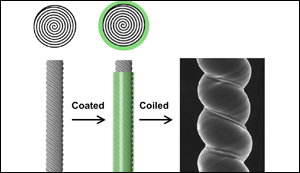Sheaths Become Mighty New Layer in Research Team’s Artificial Muscles
12. 7. 2019 | University of Texas in Dallas | www.utdallas.edu
Over the last 15 years, researchers at The University of Texas at Dallas and their international colleagues have invented several types of strong, powerful artificial muscles using materials ranging from high-tech carbon nanotubes (CNTs) to ordinary fishing line.
In a new study published in the journal Science, the researchers describe their latest advance, called sheath-run artificial muscles, or SRAMs. The research group’s previous muscles were made by twisting CNT yarn, polymer fishing line or nylon sewing thread. By twisting these fibers to the point that they coil, the researchers produced muscles that dramatically contract, or actuate, along their length when heated and return to their initial length when cooled.

To form the new muscles, the research team applied a polymer coating to twisted CNT yarns, as well as to inexpensive nylon, silk and bamboo yarns, creating a sheath around the yarn core. When operated electrochemically, a muscle consisting of a CNT sheath and a nylon core generated an average contractile power that is 40 times that of human muscle and nine times that of the highest power alternative electrochemical muscle.
Read more at University of Texas in Dallas
Image Credit: University of Texas in Dallas
-jk-




